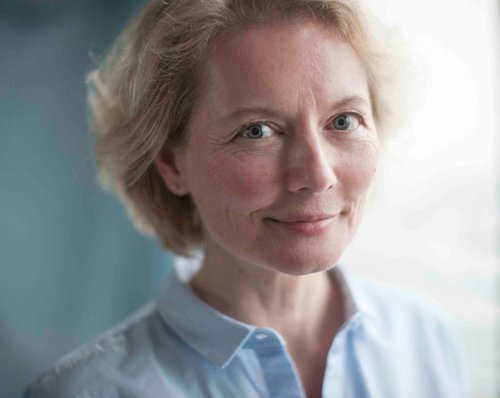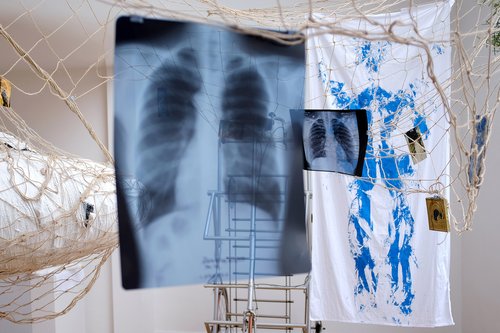Through the River of Milk: How to Recreate Aesthetics with Recycled Matter

Olga Kisseleva. The River of Milk (LUILEKKERLAND). Re:creation. Leuven, 2025. BAC ART LAB, KU Leuven. Photo courtesy of Olga Kisseleva
What compels artists to embrace reused and recycled materials? The latest stage of Olga Kisseleva’s Re-creation, presented at BAC ART LAB in Leuven, reopens the conversation.
Today the recycling and reuse of materials is very much on-trend. It is a responsible way to create art and with accelerating climate change, increasingly relevant in artistic practice everywhere. But how do artists adopt this approach? In some genres like collage, assemblage and art which uses found objects, the idea of reuse is implied per se. Some artists work exclusively with reused materials, while others incorporate them at some point in their creative journey. It is important to note that an artwork made with reused materials is not necessarily a form of recycling.
During the heyday of Moscow conceptualism artists and poets thought a lot about the significance of rubbish. In 1985, Boris Groys (b. 1947) wrote an essay about the role of rubbish in the art of Ilya Kabakov (1933-2023), stating that a pile of garbage is fundamentally different from meaningful communication and offers interesting challenges for artistic expression. According to Groys, working with garbage is also a way to reconsider the role of the artist and demonstrate a depersonalised reality. As Groys notes, Kabakov's rubbish is special because, in his works, it is meticulously 'catalogued, captioned, and organised'. Kabakov himself said that it has three connotations for him: 'an accurate image of Soviet reality', 'an archive of memories for me', and 'its incompleteness, unfinished forms, lack of thoughtfulness, and untidiness'. His fellow conceptualist poet, Lev Rubinstein (1947–2024), also worked with rubbish, but from a linguistic perspective. He referred to it as 'noise', and it became a fundamental part of his poetry. The Moscow conceptualists drew attention to what was considered unnecessary, trivial and superfluous. Moreover, by using visual and linguistic leftovers, they preserved a collective memory of late Soviet reality; otherwise, those details and aspects of life would never have been archived as they were not considered to be of any value.
Decades later, in the 2010s, Vladimir Seleznyov (b. 1973) created his installation, 'Metropolis', in which he revealed the dual nature of urban life. His work looked like a pile of trash on display in the museum but when the lights went off the discarded plastic bottles and other detritus transformed into a spectacular night-time cityscape with windows illuminated. Every time he presented the project in Seoul, The Hague, Saint Petersburg, Kazan, Yekaterinburg or Vyksa, he involved locals in every stage of the work, from collecting rubbish to installing and painting the objects and their participation was meticulously credited.
Then there are artists who do not always use rubbish and found materials of their own free will. Looking at the collages created by Sergey Parajanov (1924–1990) in a Soviet prison, it is clear that these were the only supplies available to him during his incarceration. He had previously worked in the genres of collage and installation, but at that point he did not have the liberty to choose his tools and materials. The choice of materials may be impacted also by an inability to purchase conventional art supplies due to the lack of funds. For decades, artist Tamara Zinovieva (b. 1954) has created works from a variety of materials found in city rubbish bins, including food packaging and construction materials. Her peer, Irina Zatulovskaya (b. 1954), says that the most important thing for her is "when a piece of fabric has already lived for some time, and then I add something else to it". She is fascinated by the "lost usage" of discarded objects. In the 'Ancient Shards' series, Zatulovskaya imbues ordinary fragments of stone or metal with historic value, transforming them into artefacts.
There is no doubt that interest in giving objects a second life is growing, offering new perspectives on the subject. Another example of this is the ‘Objets Trouvés’ project by Harry Nuriev (b. 1984), which was presented at Art Basel in the Chapelle des Petits-Augustins programme. Nuriev transformed the concept of re-use into an interactive art process. Visitors were invited to bring objects they no longer needed and trade them in for items left by other attendees. Nuriev elevated this exchange process to a level of social interaction, giving each visitor a sense of agency. At the end of every exchange, participants received a certificate of authenticity. As a world-renowned architect and artist, Nuriev managed to make the objects and every person who might find new value in them important. He demonstrated that each visitor can determine the significance of any object and change the way things are. He calls this approach 'Transformism', based on the idea of creating something unexpected from existing objects. The show which lasted for just one week attracted over 10,000 visitors, all of whom engaged in the process.
A new exhibition by Leningrad-born, Paris-based artist Olga Kisseleva (b. 1965), shown for just two days in mid-October in Leuven, Belgium, showcased a rare example of an established recycling project which connects numerous institutions and disciplines over a long period of time. The series forms the artistic component of the European project CirCoCréation, developed in collaboration with four major universities in Spain, Belgium, France and Sweden: KU Leuven, Universidad Complutense de Madrid, the Art & Science International Institute and Mid Sweden University. The current leg of the project was on display at BAC ART LAB, a museum located within one of the world's top-ranking universities, KU Leuven, in Belgium. The core challenge of Kisseleva’s Re-Creation is to transform waste into a resource and turn discarded matter into an aesthetic experience.
Various objects presented in the show were created from entirely bio-based and biodegradable material produced by researchers from milk residues. For Kisseleva milk represents maternal creative energy, there were huge urban flags made in the framework of the co-creative workshop ‘The River of Milk’ which were first presented in a monumental urban art installation comprising fifty flags on the bridge crossing the Adour River in South-West France. This piece refers to the 'River of Milk on the Banks of Kissel', a fictional land from Slavic fairy tales from which the project takes its title translated for local audiences into Flemish: LUILEKKERLAND. It expresses the utopian dream of an imaginary land of abundance with rivers of milk and kissel-lined banks (kissel is a traditional Northern European dessert), where the houses are made of gingerbread.
The show includes a video installation entitled ‘Ecotopia’ by Tatiana Drozd and Olga Kisseleva. In this work, a piece of biodegradable plastic made from milk dissolves in the sea, and the resulting fragments are consumed by fish. To document this process, professional diver Bernard Peyran spent two hours filming near the Côte d'Azur. Providing proof of biodegradation, the video reveals the beauty of transformation and scientific processes in an aesthetic form.
The project will continue in collaboration with artists and scientists from KU Leuven University and MaterialsBankAtelier Circuler. The Atelier collects materials from construction sites, analyses their chemical composition and the possibilities for their recycling, classifies them, and makes them available for reuse. The atelier also provided materials for the students’ performance as part of the exhibition.
The concept of recycling in art varies in terms of the material impulse and the conceptual framework. While one artist may see all unwanted, unused or discarded objects as a reflection of society, another may imbue these 'unnecessary' objects with more agency. While some artworks use recycling as a core medium, others use it as a means to an aesthetic end.















